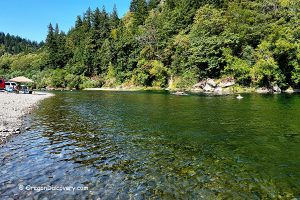
• Oregon Myrtlewood is a rare plant, native to the coastal forests of Oregon and California
• Myrtle is the most valuable North American wood
Oregon Myrtlewood, known as California Bay Laurel in California, is an ancient evergreen tree growing only in those two states. This unique tree is native to coastal forests and mountains of the Southern Coast of Oregon, the California Coast, and the western foothills of the Sierra Nevada. The scientific name of this tree is Umbellularia californica.
According to the Oregon Myrtle Association, the largest of the Myrtles 128 feet tall and 72 inches in diameter is found in the 200-year-old Myrtlewood Grove of Alfred A. Loeb State Park. Another big Myrtle is 88-foot tall with a trunk of 50-inches thick and it can be seen on the Myrtle Tree Trail, 11 miles away from Gold Beach.
Myrtlewood leaves smell similar to bay leaves but are more pungent and can be placed in flour or cornmeal to keep mealworms out. Dried leaves are still used today to add flavor to meals. Small yellowish flowers are blowing in late winter and early spring. Myrtles belong to the same family as avocado (the Lauraceae) and no surprise that their slightly spotted green round nuts look like miniature avocados.
This unique tree has a very long history starting with Native Americans using it for a variety of purposes. Native Americans used leaves to cure a plethora of diseases. Smoke from the burning tree branches was used to make ground squirrels escape from their burrows as well as to get rid of fleas.
Because Oregon Myrtlewood is hardwood featuring beautiful colors, fine-grained patterns, and burls, it is one the most expensive wood in America. The tree becomes the favorite material for small woodworking shops and individual crafters. This superior wood is used to make everything from salad bowls and spoons to guitars, furniture, paneling, and even gunstocks.
In 1933 during the great depression, coins minted out of the Myrtlewood were used as a currency. The only bank in North Bend closed doors to prevent depositors from rushing in and withdrawing all their money. The city used the same bank's cash reserves to pay employees.
North Bend officials decided to mint its own currency out of Myrtlewood disks by using a newspaper printing press. The city produced coins denominating from 25 cents to 10 dollars and promised to redeem new currency for dollars as soon as it had cash reserves to do so.
Many people in North Bend ended up keeping the Myrtlewood coins as collector's items and as a result, the city decided to accept those as legal tender in perpetuity. Technically, you can still use the Myrtlewood Dollars to pay in North Bend today.
Cautions: Consumption and other culinary use of Myrtlewood is not recommended. The plant contains umbellulone which can cause severe headaches and safrole which was banned for human consumption by the FDA because of its cancerogenic properties.
You May Also Like





Do you have any sources for the parts about uses of Myrtle wood with indigenous tribes, or the use of it as currency in 1930’s?